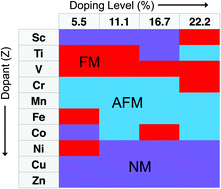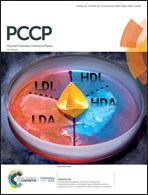Dramatic magnetic phase designing in phosphorene†
Abstract
Phosphorene is a unique two-dimensional semiconductor that exhibits huge potential for nanoelectronic, optoelectronic and spintronic applications and their cross-hybrid electronics. In particular, creation of magnetic phases in phosphorene selectively can provide a multitude of opportunities for developments in 2D spintronic circuits. Doping phosphorene with transition metal atoms can induce sustainable magnetic ordering, making it a diluted magnetic system, however, the viability of high temperature magnetic phases and potential control remain unanswered. In this work, using first-principles calculations, we uncover the impact of doping phosphorene with various 3d block elements (Sc, Ti, V, Cr, Mn, Fe, Co, Ni, Cu and Zn) in increasing order of atomic number at various levels of doping. Such an extensive study helps us to find the doping conditions that lead to remarkable feasibility of ferromagnetism and antiferromagnetism up to a strikingly large temperature ∼1150 K, evaluated by mean field theory. The doping concentration and atom type can be used to systematically tune the phases from ferromagnetic and antiferromagnetic to non-magnetic ground states. Our work provides new guidelines for engineering multi-functional spintronic components using phosphorene as a base material for all-phosphorene spintronics.



 Please wait while we load your content...
Please wait while we load your content...